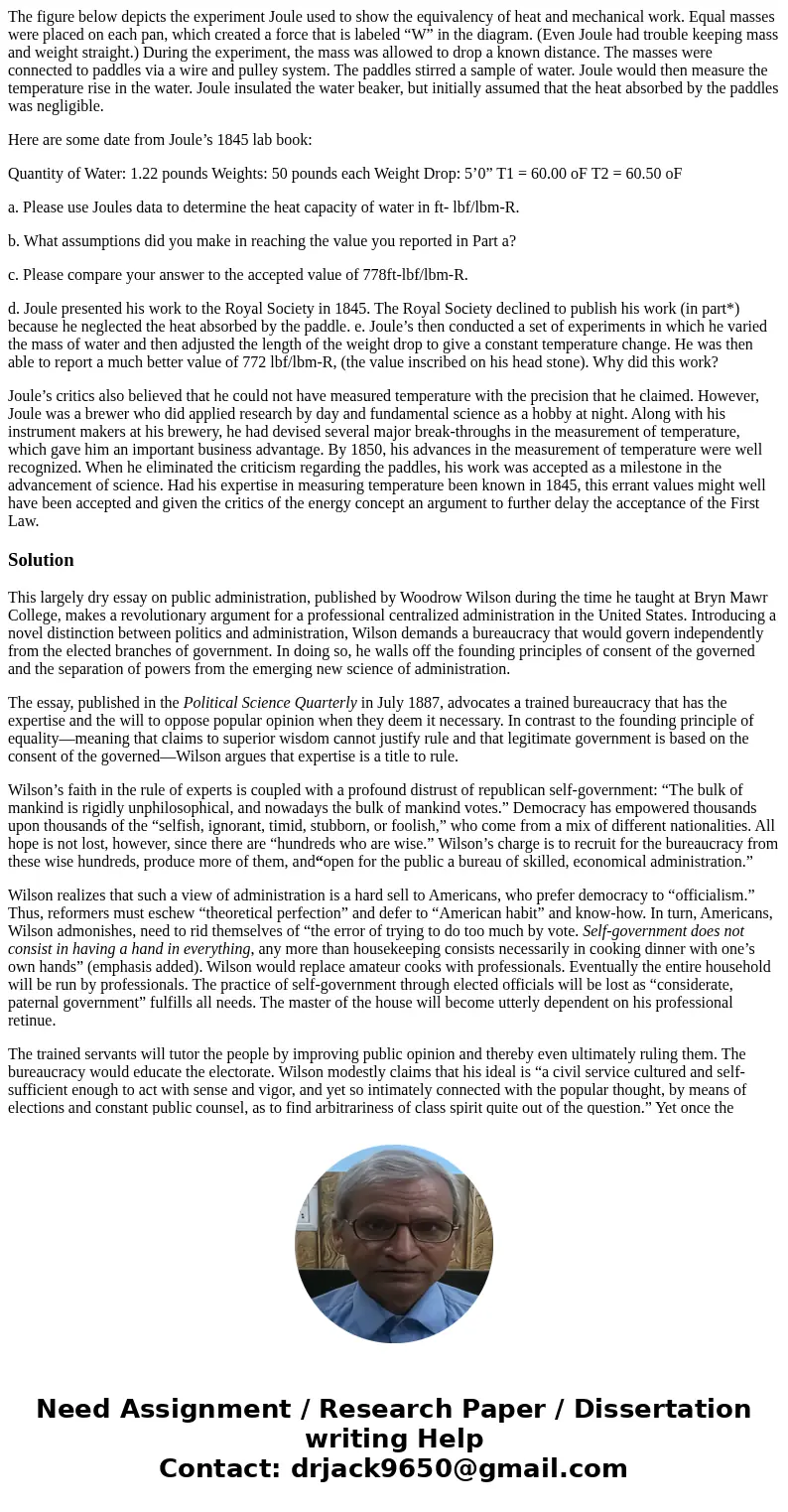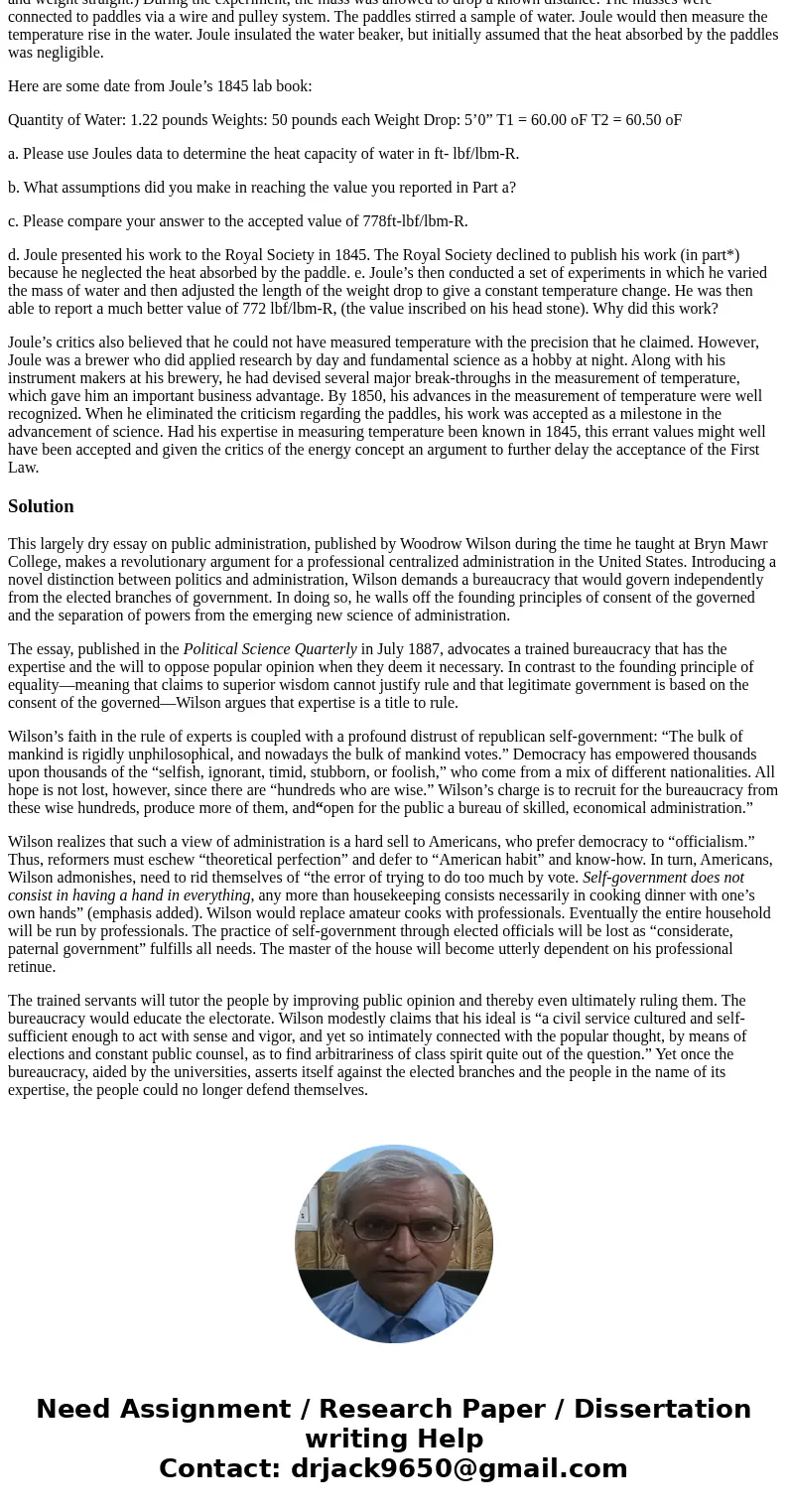The figure below depicts the experiment Joule used to show t
The figure below depicts the experiment Joule used to show the equivalency of heat and mechanical work. Equal masses were placed on each pan, which created a force that is labeled “W” in the diagram. (Even Joule had trouble keeping mass and weight straight.) During the experiment, the mass was allowed to drop a known distance. The masses were connected to paddles via a wire and pulley system. The paddles stirred a sample of water. Joule would then measure the temperature rise in the water. Joule insulated the water beaker, but initially assumed that the heat absorbed by the paddles was negligible.
Here are some date from Joule’s 1845 lab book:
Quantity of Water: 1.22 pounds Weights: 50 pounds each Weight Drop: 5’0” T1 = 60.00 oF T2 = 60.50 oF
a. Please use Joules data to determine the heat capacity of water in ft- lbf/lbm-R.
b. What assumptions did you make in reaching the value you reported in Part a?
c. Please compare your answer to the accepted value of 778ft-lbf/lbm-R.
d. Joule presented his work to the Royal Society in 1845. The Royal Society declined to publish his work (in part*) because he neglected the heat absorbed by the paddle. e. Joule’s then conducted a set of experiments in which he varied the mass of water and then adjusted the length of the weight drop to give a constant temperature change. He was then able to report a much better value of 772 lbf/lbm-R, (the value inscribed on his head stone). Why did this work?
Joule’s critics also believed that he could not have measured temperature with the precision that he claimed. However, Joule was a brewer who did applied research by day and fundamental science as a hobby at night. Along with his instrument makers at his brewery, he had devised several major break-throughs in the measurement of temperature, which gave him an important business advantage. By 1850, his advances in the measurement of temperature were well recognized. When he eliminated the criticism regarding the paddles, his work was accepted as a milestone in the advancement of science. Had his expertise in measuring temperature been known in 1845, this errant values might well have been accepted and given the critics of the energy concept an argument to further delay the acceptance of the First Law.
Solution
This largely dry essay on public administration, published by Woodrow Wilson during the time he taught at Bryn Mawr College, makes a revolutionary argument for a professional centralized administration in the United States. Introducing a novel distinction between politics and administration, Wilson demands a bureaucracy that would govern independently from the elected branches of government. In doing so, he walls off the founding principles of consent of the governed and the separation of powers from the emerging new science of administration.
The essay, published in the Political Science Quarterly in July 1887, advocates a trained bureaucracy that has the expertise and the will to oppose popular opinion when they deem it necessary. In contrast to the founding principle of equality—meaning that claims to superior wisdom cannot justify rule and that legitimate government is based on the consent of the governed—Wilson argues that expertise is a title to rule.
Wilson’s faith in the rule of experts is coupled with a profound distrust of republican self-government: “The bulk of mankind is rigidly unphilosophical, and nowadays the bulk of mankind votes.” Democracy has empowered thousands upon thousands of the “selfish, ignorant, timid, stubborn, or foolish,” who come from a mix of different nationalities. All hope is not lost, however, since there are “hundreds who are wise.” Wilson’s charge is to recruit for the bureaucracy from these wise hundreds, produce more of them, and“open for the public a bureau of skilled, economical administration.”
Wilson realizes that such a view of administration is a hard sell to Americans, who prefer democracy to “officialism.” Thus, reformers must eschew “theoretical perfection” and defer to “American habit” and know-how. In turn, Americans, Wilson admonishes, need to rid themselves of “the error of trying to do too much by vote. Self-government does not consist in having a hand in everything, any more than housekeeping consists necessarily in cooking dinner with one’s own hands” (emphasis added). Wilson would replace amateur cooks with professionals. Eventually the entire household will be run by professionals. The practice of self-government through elected officials will be lost as “considerate, paternal government” fulfills all needs. The master of the house will become utterly dependent on his professional retinue.
The trained servants will tutor the people by improving public opinion and thereby even ultimately ruling them. The bureaucracy would educate the electorate. Wilson modestly claims that his ideal is “a civil service cultured and self-sufficient enough to act with sense and vigor, and yet so intimately connected with the popular thought, by means of elections and constant public counsel, as to find arbitrariness of class spirit quite out of the question.” Yet once the bureaucracy, aided by the universities, asserts itself against the elected branches and the people in the name of its expertise, the people could no longer defend themselves.


 Homework Sourse
Homework Sourse